Quality of the Environment in Japan 1993
(3) Promotion and Induction of Activities in Private Sector
A check of the present pattern of environmental issues reveals that the principal issues have shifted from those which center on specific kinds of large-scale project activities, to broad activities which extend from factories to business offices and households. In order to work for environmental conservation in the midst of this trend, it is necessary to build a society where environmental considerations will be appropriate- ly incorporated in all sorts of socioeconomic activities. As ways in which the government works on the various activities of society for realization of that direction, the regulatory measures defined as princi- pal measures and methods in the system of laws based on the conven- tional legislation are no longer sufficient, as we have seen from the cases introduced in Section 1. Besides, it is necessary to appropriately interlace the diverse workings of government to encourage a wide variety of entities in society to voluntarily wrestle with environmental conservation.
In order to encourage approaches in society for environmental conservation, the primary need is to encourage the people and entrepre- neurs to appropriately realize the present conditions of the environment and relations between various activities and the environment. For this, it is an important duty of the government to enhance public-relations activities, environmental education and the offer of information. It is also important to encourage the private sector's voluntary activities. For this, it is necessary to present a guideline for activities and offer information about the examples of desirable approaches and expected effects. With this in mind, the aforementioned Bill for the Basic Envi- ronmental Law incorporates provisions for promotion of nongovern- mental activities.
In fiscal 1992, for example, the Environment Agency formulated the Guideline on Corporate Acts Amiable to the Environment with the participation of specialists in industry and persons of learning and experience and offered it for reference purposes to businesses which were to act in a manner amiable to the environment. The Ministry of International Trade and Industry called on each business to prepare a voluntary program for the environment.
It is of use to develop society where a wide variety of activities are intertwined into one where environmental conservation is worked out as a whole, and to take diverse methods, depending on the pattern of the problem posed--instead of sticking to regulatory measures, such as an across-the-board ban which has conventionally been the principal method--in situations where the distribution and preparation of mea- sures and efforts to realize the prevention of environmental degradation and upgrade sustainability diversely exist.
Internationally, the economic method whose advantage is to effectively use the vitality of markets is recommended. In Principle 16 of the Rio de Janeiro Declaration, it is stated that "national authorities should endeavor to promote the internationalization of environmental costs and the use of economic instruments, taking account of the approach that the polluter should, in principle, bear the cost of pollution, with due regard to the public interest and without distorting interna- tional trade and investment." In the OECD Governing Council's Recom- mendation on the Use of Economic Means in Environmental Policy in 1991, the OECD enumerated (1) surcharges and taxes, (2) dealings in the right to emission on the market, (3) the deposit system and (4) aid in funds (subsidiaries and so on) as economic means and recommended their use while taking account of the social and economic conditions of each member country. In line with such a pvrpose, the OECD released in March 1993 the report prepared by the Working Group on the Tax System and the Environment, jointly established by the Tax Committee and the Environmental Policy Committee.
A check of the economic methods of countries around the world indicates that there are cases in which funds in (4), above, ars used to encourage measures to cope with industrial pollution. Japan has also taken various subsidization measures, such as the establishment of a preferential tax system on autos satisfying the latest series of exhaust gas controls, as will be introduced in 4, Section 1, Chapter 1, Part 2.
Table 4-2-5 Taxes, Surcharges, Dealings in Right to Emission and Deposit System in World Countries
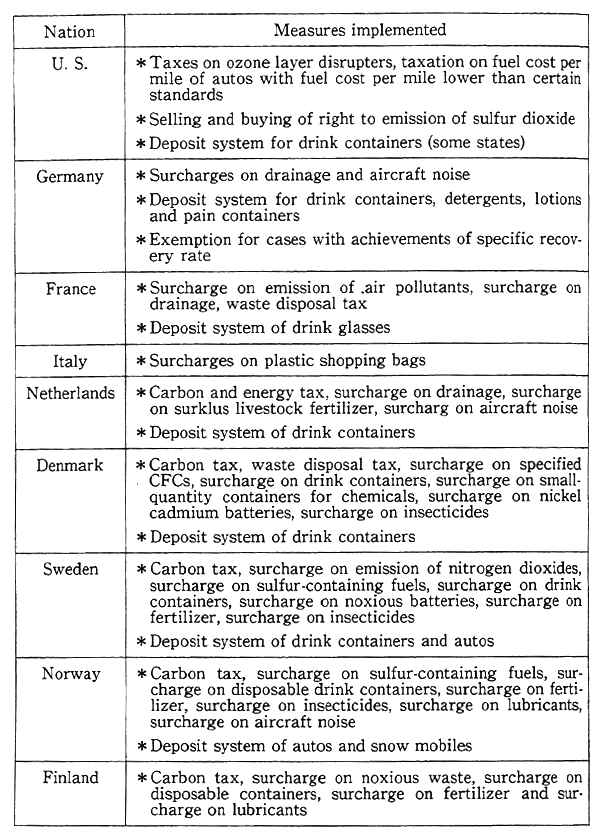
Source: Prepared from data from OECD and Clean Japan Center.
When it comes to methods in which some economic burden is imposed on acts which produce loads on the environment for a volun- tary constraint on such acts, France and Germany began to impose surcharges on wastewater in the 1960s. In recent times, the introduction of this system has become widespread in an attempt to cope with such a new pattern of environmental issues as we have introduced earlier (Table 4-2-5). In Denmark, for example, followed the example of Sweden, Norway, Finland and the Netherlands which had already introduced a tax system designed to reduce carbon dioxide emissions. With a revision of the Air Conservation Act in 1990, the United States introduced a framework of dealings in the right to emission with a view to cutting back phosphorus dioxide as a measure to cope with acid rain, and dealings in the right to emission are drawing attention, having started in March 1993. The deposit system has long been enforced on drink containers. In Germany, entrepreneurs are obligated to take back containers under the Administrative Ordinance on the Avoidance of Packed Wastes based on the Waste Avoidance and Control Act. This act also orders the depositing of non-recyclable drink, detergent, clean- ing agent and paint containers. The obligation of taking back packaging and depositing non-recyclable containers is so designed that it may not be imposed in situations where a recovery system with the involvement of entrepreneurs is developed and a specific recovery rate is satisfied. Given this rule, Dual System Deutschland, a private firm, was estab- lished, and more than 600 corporations have become its members.
In Japan, too, provisions for such measures are incorporated in the Bill for the Basic Environmental Law. In this provision, the neces- sary and appropriate economic subsidization is defined as an economic measure to prevent barriers to environmental conservation, and mea- sures on economic burdens are newly provided for. The bill expressly says that such measures on economic burdens are expected to become valid and internationally lauded. Next, now that those measures are something which calls for the people to share burdens, it says that there is the need to appropriately survey and study the effects of the measures and their impacts on the economy, among others. On the basis of those surveys and researches, the bill says that efforts will be made to secure the understanding and cooperation of the people in situations where individual measures are required. It also says that in case those mea- sures are taken for conservation of the global environment, such as measures to cope with global warming and so forth, they will be taken with consideration given to international coordination. In line with the notion introduced in the foregoing, it is necessary to conduct surveys and researches while referring to the findings of researches and exam- ples, among others.
(4) Promotion of International Efforts
As the causes and impacts of environmental issues proliferate across national boundries, there are growing calls for more coordinated efforts by various countries in addition to those made in those countries. As developing countries are already confronted with grave environmen- tal issues, there are international calls for aid by developed countries, given the striking shortage of funds, manpower, technology and so on and the inadequacy of legal institutions and administrative systems for enforcement. As we have seen in Section 3, Chapter 3, such assistance provides security for the entire Earth, and it was internationally agreed at the Earth Summit to step up aid in the spirit of global partnership, while paying heed to the common responsibilities, albeit different in nature, of developed and developing countries.
As we have seen in Section 1, Chapter 4, Japan has been im- plementing a wide variety of internal measures for conservation of the global environment and international measures as it became a party to various environment-related international conventions (Table 4-2-6). Moreover, in order to comprehensively and effectively promote a broad range of measures on the global environment with the close liaison of related administrative institutions, the government established a Coun- cil of Ministers Related Conservation of the Global Environment in May 1989. At its first meeting, the council approved six items, including Japan's active involvement in the building of an international frame- work for conservation of the global environment. In line with this accord, various measures are being promoted. In July 1989, the post of minister in charge of problems on the global environment was newly created to work for smooth responses within the government to prob- lems of the global environment, and the Director-General of the Environ- ment Agency has concurrently assumed this post since then. The Minister in Charge of Problems of the Global Environment coordinates the global environment-related budgets of ministries and agencies, among other duties.
Table 4-2-6 Major Enuironment-Related Conventions and Treaties With Japan as Signatory
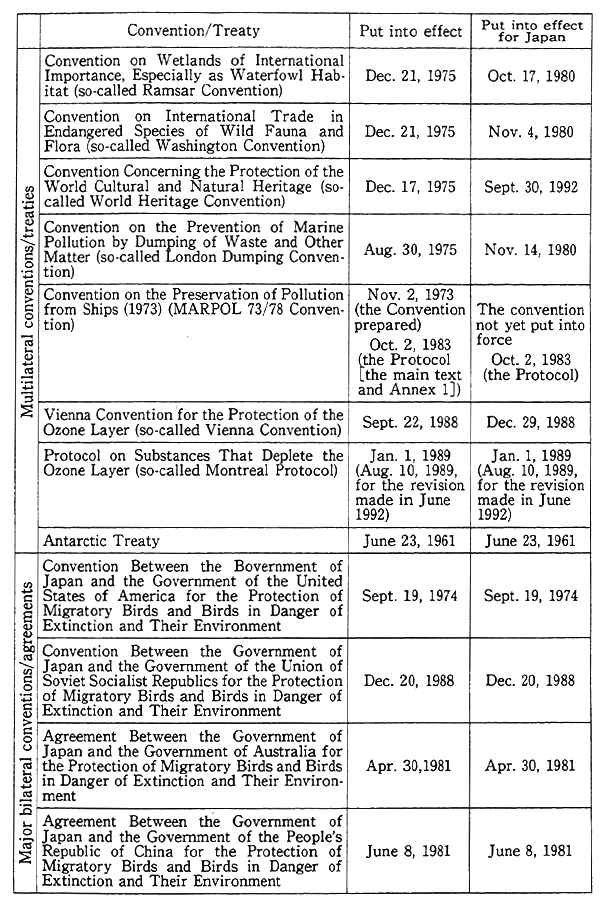
In April 1992, the Eminent Persons Meeting for Financing Global Environment and Development was held in Tokyo under the sponsorship of the Secretariat of the U. N. Conference on Environment and Develop- ment (Earth Summit), and Japan cooperated in sponsoring this confer- ence. The outcome (Tokyo Declaration) set the course for international accord on questions about financing at the Earth Summit. Japan introduced this declaration to the Conference of Developing Countries' Environmental Ministers (Kuala Lumpur) in April and the Conference of Developed Countries' Environmental Ministers (Bonn) in May, making significant international contributions. In May, the sixth Related Minis- ters' Conference on Conservation of the Global Environment was held, where the document "On Japan's Approaches to the Earth Summit" which described Japan's efforts was presented. In the text of Prime Minister Kiichi Miyazawa's speech presented to the Earth Summit, Japan made clear a policy of multilateral environmental cooperation, including cooperation with the International Development Agency (IDA) and the Global Environmental Facility (GEF) managed by the World Bank and other institutions. It also made clear a policy of expanding and reinforcing Japan's environment-related official development assis- tance from ¥900 billion to ¥1 trillion over five years from fiscal 1992. Given this policy, it was incorporated in the Outline for Official Develop- ment Assistance to "strive for sustainable development in a global dimension while aiming at the achievement of environmental conserva- tion." In October, the UNEP International Environmental Technology Centers were established in Osaka City and Shiga Prefecture in response to a ploposal Japan made at the Earth Summit. The centers are designed to provide training and consulting for the transfer of technology amiable to the environment to developing countries and so on. As part of the follow-up of the Earth Summit, the first Sea of Japan Rim Environmental Cooperation Conference was held in October under the cosponsorship of the Environment Agency and Niigata Prefecture for the exchange of views and information about the environment of Northeast Asia.
Japan's international environmental assistance, like other inter- national aid, consists of gratuitous-fund cooperation, technical coopera- tion and cost-sharing cooperation. Trends in international environmen- tal assistance are shown in Fig. 4-2-35. In recent years, there have been signs of a striking rise. The substance and definition of environmental assistance varies, depending on the aid-receiving country, so that it is difficult to make an international comparison, but the scale of environ- mental assistance extended by Japan might be described as the Largest among major -countries. In order to step up grass-roots international environmental assistance on a nongovernmental basis as "global citi- zens," in addition to international environmental cooperation on a governmental basis, a bill calling for a revision of the Japan Environ- mental Association Law was submitted to the Diet in February 1993 to establish a global environment fund.
Fig. 4-2-35 Actual ODA in Environmental Sector (By Form)
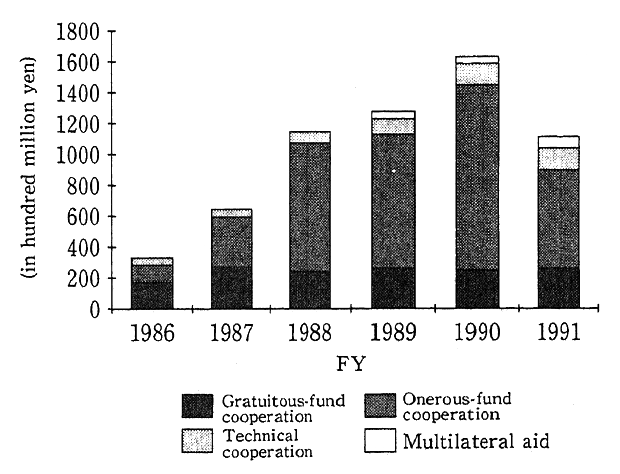
Source: Environment Agency
In view of the growing importance of the global perspective and international efforts, the Bill for the Basic Environmental Law incorpo- rates provisions for promoting conservation of the global environment, and its concrete policy measures include the promotion of international cooperation in conserving the global environment, the environment of developing countries and so forth, personnel training, the collection, classifying and analysis of information, surveillance, observation, sur- veys, researches and so on for promotion of international cooperation in conservation of the global environment by local governments and the private sector, and by the State and in private corporate activities abroad, among others. There are few examples in developed countries in which the ideals and substance of international environmental cooper- ation are legally defined, and the bill turns out to be pioneering.
(5) Basic Surveys and Researches
When it comes to today's environmental problems, as is the case with problems of global warming, there are many points which have yet to be made clear, such as their mechanisms and impacts, and there is the need to step up the observation, surveillance, surveys and researches of environmental conditions and the development of pioneering technol- ogy, among others. In such a basic sector of science and technology, it is difficult for businesses to respond on a paying basis, Particularly when it comes to conservation of the global environment, the sector of related sciences is broad in scope and the research subjects are interna- tionally spread, it is necessary to make multidisciplinary and interna- tional studies and appropriately reflect their findings on measures. Having said that, it is important for the government to promote them in a positive manner. As for the balance of absorption and discharge of carbon dioxide on the entire Earth, for example, there are missing sinks which have yet to be understood, constituting a significant issue in the prediction of global warming in the future, so that related institutions are cooperating in researches on the circulation of carbon around the world, including the clarification of missing sinks. Researches are supported and the interchanges of researchers are done at the Global Environment Research Center established in the National Institute for Environmental Studies in 1990.
In a perspective of the integration of environment and economy, the importance of surveys and researches in terms of social science is rising. For example, the importance of parameters which make possible the comprehensive evaluation of the environment and the economy has been internationally recognized to contribute to decision-making with environmental considerations in the sector of economic policy in attempts to build a sustainable economic society with less environmen- tal loads. There are calls for the development of a system of parameters long-term development, while taking account of environmental pollution and the depletion and degradation of natural resources, and the develop- ment of an Environmental Resource Accounting and an Environment- and-Economy Integration Account in the System of National Account- ing (SNA). It is also important to promote studies which will offer information for such policy and decision-making. To date, the U. N. Statistic Bureau, the World Bank and the World Resource Research Institute, among others, are studying various systems of accounting and made a trial calculation on that basis. In Norway, France and the Netherlands, attempts have actually been made to prepare environmen- tal resource accounts. The Government of Norway began studies on environmental resource accounts in which various environmental fac- tors are expressed in terms of quantitative units. The system of account- ing is established as environmental resources are classified into "mate- rial resources" which are consumed in production as a flow (mineral resources, biological resources, and sunlight, hydraulic power and other flow-in resources) and "environmental resources" which are changed but not consumed in the production process (air, water, soil and so forth) (Table 4-2-7). An account of "material resources" is prepared for some mineral resources, fish and forests, and for all those, data on the total stock and the changes and causes in a certain period are compiled. Some "environmental resource" accounts are concerned with land utilization and emissions in the atmosphere, and as regards land utilization, data on the classification of land uses and the land quality are compiled. On emissions in the atmosphere, data on the emission of pollutants and their generation sources are compiled. This system of accounting is used in projecting and planning the utilization of resources in the future. In 1993, the United Nations decided to revise the System of National Accounting (SNA) and include the environment-and-economy integra- tion account. At present, a handbook is under preparation. In Japan, research institutions of the Environment Agency, the Economic Plan- ning Agency and the Ministry of Agriculture, Forestry and Fisheries are stepping up studies to work for the establishment of an environment- and-economy integration account and to check into methods to add the environment-and- economy integration account to the system of national accounting, including studies to check into SEEA methods and so forth.
Table 4-2-7 Classification of Natural Resources in Sweden's Environ-mental Resource Account
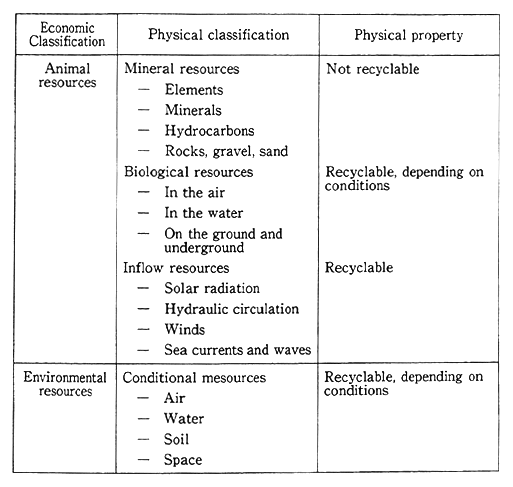
Source : Hosono
In the Bill for the Basic Environmental Law, it is stipulated that the State would work for the promotion of aforementioned science and technology for environmental conservation and take measures for development of a test and research system and the promotion of research and development.
(6) Improvements in Institutions and Administrative Management
There is no need to say that the government should concentrate its efforts on the planning, drafting and promotion of tangible measures, but there are calls for the improvement and development of institutions and systems, uninterruptedly review them or make administrative management more reasonable. As we have seen in Section 3, Chapter 3, the government presented to the Diet the Bill for the Basic Environmen- tal Law which would constitute a new framework of measures for environmental conservation fitted to the era of the global environment. In the following, let us look back on what work has been done for improvements in environmental administration with the Provisional Administrative Reform Promotion Council and administrative inspec- tions as examples.
For the promotion of administrative reform, the Provisional Administration Research Council was established in 1981, and the Provisional Administrative Reform Promotion Council was established later. At present, surveys and deliberations are made at the third Provisional Administrative Reform Promotion Council on measures for the improvements in the administrative system and the management of administration in response to the recommendations of the two previous councils. In the Second Recommendation on Administrative Reform with Serious Account Taken of Response to Internationalization and the National Life made in December 1991, the way in which administra- tion on conservation of the global environment should be was taken up, and proposals were made on the formation of a basic policy and so forth on problems about the global environment, the development of a system in which problems on the global environment could be coped with, such as the display of the Environment Agency's planning and functions for comprehensive coordination and the promotion of international cooper- ation, among others.
Administrative inspections are designed to evaluate administra- tion in an a wide perspective. Concrete themes are set, the actual state of administration and the problems posed are investigated and analyzed, and on the basis of the findings, recommendations are made to the relevant ministries and agencies on measures for improvements. By so doing, administrative inspections aim at promoting administrative reform and improvement in all aspects of systems, measures, organiza- tion and management. The recommendations and the measures taken in response to them are announced to the public. The recommendation related to environmental conservation to date include the Administra- tive Inspection on Environmental Control Measures in 1971 and the Administrative Inspection on Nature Protection in 1972, among others, as shown in Table 4-2-8.
Table 4-2-8 Administrative Inspections on Environmental Conservation
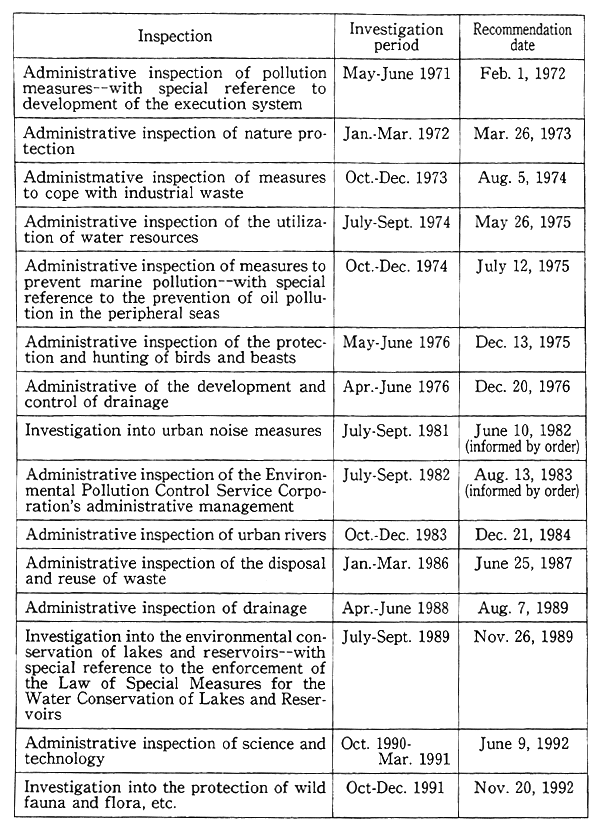
Source : Prepared by the Environment Agency from the Administrative Inspection Yearbook (each year)
A check of recent administrative inspections reveals that in the Survey on the Environmental Conservation of Lakes and Reservoirs recommended in fiscal 1990. it was recommended that the link of ministries, agencies and prefectures associated with various water conservation projects be closer for a drastic reinforcement of the household effluent measures in areas designated under the Law of Special Measures for the Water Conservation of Lakes and Reservoirs, and that studies be conducted on a enhancement and strengthening of the lake and reservoir water conservation programs. Given this recom- mendation, the Environment Agency and so forth established a Liaison Council of Ministries and Agencies Related to Designated Lakes and Reservoirs for the exchange of information and views, making the liaison work closer and stepping up the household effluent measures. For Lake Biwa and six other lakes and reservoirs for which the second Lake and Reservoir Water Conservation Program was formulated in fiscal 1991 and 1992, measures for the prevention of eutrofication were enhanced, such as by adding nitrogen and phosphorus to COD and efforts are being made for a strengthening of the Lake and Reservoir water Conservation Program.
Next, a recommendation was made on the basis of the findings of the Survey on the Protection of Wildlife, Etc., in fiscal 1992. It was recommended that in regard to the basic survey on conservation of the natural environment, the substance of the survey be enhanced such as the scope of survey subject species, and the habitation and growth of wildlife be understood in a more appropriate manner. In order to promote the conservation of places for the habitation and growth of endangered wildlife, habitats are tobe designated under the Law for Conservation of Endangered Wild Fauna and Flora Species and the preservation of endangered fauna and flora be is tobe taken into account in designating special areas and so forth under the Natural Environment Conservation Law, and appropriate and systematic protec- tion and propagation projects will be promoted.
As environmental issues came to associate themselves with a broad range of sectors, administration for environmental conservation has become complex and diverse, and improvements in administration on the basis of the results of administrative inspections have become important.
In addition, the environmental administrative department and bureau of each local government must respond to public grievances and petitions on environmental administration. As for the central govern- ment, the investigators and so forth assigned to the regional administra- tive inspection bureaus across the nation, which are the branches of the Management and Coordination Agency, provide consulting services on administration under the jurisdiction of the Environment Agency. Having assigned consultants, the head office of the Environment Agency accepts petitions from people in general to contribute to improvements in administration. Incidentally, the head office of the Environment Agency accepted 119 petitions in fiscal 1992.
4-2-5 International Institutions
Today, the world's economic and social activities encompass a broad range of sectors, such as trade and finance, and heighten their interdependence. In such circumstances, international institutions have come to play a significant role. Particularly when it comes to such trans-boundary issues as conservation of the global environment, the adjustment of interrelated interests between countries, the presentation of effective solutions and the encouragement of coordination between countries are something which can no longer be realized without the assistance of international institutions. In the sectors of security and international economics, it has already become a routine practice to negotiate in a system of international coordination. Naturally, interna- tional institutions are expected to play a greater role in the sector of environmental issues which rtanscend national boundaries.
At the Earth Summit, the Rio Declaration on Environment and Development and Agenda 21 were adopted, the Framework Convention on Climate Change and the Convention on Biological Diversity were concluded, agreement was reached on a framework for the 21st century, as is the case with the non-legally binding authoritative Statement of Principles for a Global Consensus on the Management, Conservation and Sustainable Development of All Types of Forests, and international society has begun to work for their realization. Particularly at the 47th U. N. General Assembly held from November to December 1992, a follow-up on the Earth Summit was discussed in detail. As a result, it was decided to establish a Committee on Sustainable Development in the United Nations, as we have already introduced in Section 3, Chapter 3. The lines of duty assigned to this committee consist of reports compiled U. N. activities for the implementation of Agenda 21 for presentation to the U. N. General Assembly. The establishment of such an organization in addition to the United Nations Environment Pro- gramme (UNEP), which has developed specialized activities in environ- mental conservation, is expected to further reinforce U. N. activities in the environmental sector. Also at the U. N. General Assembly, a large number of achievements were made, as it was agreed, for example, to make March 22 of each year the World's Water Day and to hold an intergovernmental conference in 1993 on straddling stocks (fish resources in and out of the 200-mile zone, etc.), among others, to be cocluded before the U. N. General Assembly in the fall of 1994.
On the basis of the U. N. General Assembly debates we have just seen, measures to realize the Earth Summit commitments have been formulated at various levels. First, as regards the aforementioned Framework Convention on Climate Change and Convention on Biodiver- sity, studies on various tasks necessary for its enforcement have begun. On the prevention of desertification, an intergovernmental committee has been established in the U. N. General Assembly to formulate a convention for the prevention of desertification, by June 1994.
The United Nations Environment Programme (UNEP), which takes charge of environmental problems within the framework of the United Nations, has developed activities in a broad range of sectors to comprehensively grapple with serious global environmental issues. Particularly, UNEP established a UNEP International Environmental Technology Centre in Japan in 1992 for the transfer of technologies for environmental conservation to developing countries and so forth. In January 1993, Elizabeth Dowdeswell of Canada was nominated the third general secretary. This U. N. body is expected to further reinforce the U. N. after the Earth Summit.
In the United Nations Development Programme (UNDP) which takes charge of technical cooperation within the framework of the United Nations, plans are taking shape for support in the field of software with a view to assisting in the enhancement of developing countries' capability to respond to environmental problems, such as the training of personnel, a key to the solution of environmental issues, and technical cooperation.
When it comes to other international institutions, the Organiza- tion for Economic Cooperation and Development (OECD), for example, holds international debates on environmental issues in environment and economy, environment and development and many other perspectives with the central role played by the Environmental Policy Committee established at an OECD reorganization in March 1993. At the summits of industrial democracies, brisk discussions have evolved about environ- mental problems through economic declarations and so on, indicating that in recent years, environmental issues have been taken up as an important task.
Efforts have also started for the formulation of measures to support the capability of grappling with problems on the global environ- ment and developing countries' environmental issues. As for the Global Environmental Facility, jointly managed and funded by the World Bank, the United Nations Development Programme (UNDP) and the United Nations Environment Programme (UNEP), debate is under way so that agreement may be reached on improvements in the management method and the scale of funds on the basis of an accord of the Earth Summit by the end of 1993.
On trade, one of the important sectors for the realization of sustainable development, debate is under way at the General Agreement on Tariffs and Trade (GATT), the Organization for Economic Coopera- tion and Development (OECD) and the International Tropical Timber Organization (ITTO).
Environmental cooperation at the regional level is also being stepped up at the initiative of international institutions. In East Asia, a conference has been held in Beijing for the formulation of a Northwest Pacific Sea Region Program at the initiative of the UNEP as part of its program on regional seas with the participation of Japan, China,. Russia, the Republic of Korea and the Democratic People's Republic of Korea. Hopes are pinned on its success, as there has been no sea region program for East Asia. As regards cooperation in the Northeast Pacific region, the first Environmental Cooperation Conference for the Sea of Japan Rim was held as an expanded forum of the Japan-Republic of Korea Environmental Symposium held annually. On the basis of such achievements, a meeting of senior officials for environmental coopera- tion in the Northeast Asian region was held in Seoul in February 1993, and a meeting of senior officials on environment and development was held in Kuala Lumpur, thus embarking upon studies on concrete approaches in the Asian-Pacific region. Besides, the Food and Agricul- tural Organization (FAO), the World Health Organization (WHO) and other U. N. specialized institutions and the International Monetary Fund (IMF) and other international institutions are reinforcing approaches to environmental issues in projects under their respective jurisdiction. Those activities of international institutions with which Japan is closely tied are enumerated in Section 2, Chapter 8, Part 2, of this fiscal year's White Paper on Environment.
Countries around the world contribute funds to those interna- tional institutions for their efforts and are reinforcing cooperation in funding, manpower, knowledge and many other sectors by carrying out projects with the GEF, UNDP and so forth.
For mankind's future, international institutions' greater activities are indispensable. Japan has made significant contributions to the United Nations in funding terms, having the world's second largest membership share after the United States. In the future, it is necessary to strengthen a broad range of cooperation commensurate with Japan' s international position, such as the reinforcement of manpower contri- butions--which remains inadequate as the number of the Japanese staff officials in the United Nations (about 100 at present) remains far below the desirable number (described as 100 or so)--and the offer of experi- ence and kno--how, not only fund contributions. There is also the need to take the lead in rendering cooperation as a model for other countries, such as by contributing to the building of international frameworks, so that fruitful international decisions may be made particularly in the environmental sector.
PartII
Chapter 5. Comprehensive Promotion of Environmental Administration
5-1 On the Bill of the Basic Environment Law
5-1-1 Background
Japan's administration of environmental affairs has been carried out under the Basic Law for Environmental Pollution Control enacted in 1967 and the Nature Conservation Law legislated in 1972, having played a significant role in preventing environmental pollution and conserving nature.
However, the framework of the two laws mentioned above, which centers around contronl measures, has become insufficient to meet the broadened object domain of environment policy today. It is now necess- sary for business, industry and the people as a whole, as well as the State and local autonomies, to tackle with environmental problems, Some of the problems requiring urgent attention and actions are global environmental problems, including global warming and depletion of the ozone layer. It is also necessary to take appropriate measures especially against pollution caused by urban life and modernization, including air pollution by nitrogen oxides in big cities, water contamination from household effluents in semi-closed water areas and mounting wastes. In fact, every one is required to review, by making use of all available means, today's socioeconomic systems and life styles.
5-1-2 Circumstances
With respect to the legislation of the Basic Environment Law, the Prime Minister in April 1992 instructed the ministries and agencies concerned to consider legislating new laws to meet the global environ- ment era. It was followed by a Cabinet decision in June to legislate new laws in response to demands of the timeas described in the "Five-Year Economic Plan: Sharing a Better Quality of Life Around the Globe." Under these circucmstances, a joint report on the way the basic environ- ment legislation should be as part of a reply to an inquiry on the "Way Environment Policy Should Be in the Age of Globalization" in Decem- ber 1991 to the Minister of State, Director-General of the Environment Agency, by the Central Council for Environmental Pollution Control and the Nature Conservation Council. The report was based on an extensive study covering results of the Earth Summit and hearings from the parties concerned.
On the basis of this report, the Cabinet gave oral understanding on the "Drafting of the Bill of the Basic Environment Law (the provi- sional name then)" on October 23, and the Government went ahead with the drafting of the Bill of the Basic Environment Law. As an outline of the bill was drawn up. the Prime Minister made an inquiry to the Central Council for Environmental Pollution Control as to the super- sedence of the Basic Law for Environmental Pollution Control with the proposed Basic Environment Law, and he received a reply in f over of the plan on March 8, 1993. On March 12, the Cabinet, based on this reply, decided upon the "Bill of the Basic Environment Law" and the Bill of the Law Concerning the Enactment and Abolition of the Relevant Laws with the Enforcement of the Basic Environment Law," and presented them to the National Diet.
5-1-3 Outline of the Bill of the Basic Environment Law
As its fundamental rule for the conservation of environment, the Bill of the Basic Environment Law first of all prescribes three principles : the enjoyment and future succession of environmental blessings, crea- tion of a society ensuring sustainable development with reduced environ- mental loads, and active promotion of global environment conservation through international cooperation. At the same time, the bill makes clear the responsibilities of the State, local governments, corporations and citizens as a whole for the conservation of environment.
Secondly, the bill, stating explicitly guidelines for the formulation and implementation of policies for the conservation of environment, requires the State to establish basic environment plans and to show before the pople outlines of the policies adopted. It also provides for environmental quality standards, environmental pollution control pro- grams, considerations in formulation of policies by the State etc., promotion of environmental impact assessments, regulations to prevent interference with the conservation of environment, economic measures to prevent interference with environmental conservation, promotion of construction of facilities and other projects for the conservation of environment, promotion of the use of products contributing toward reduced loads to environment. It also stipulates the promotion of educa- tion and learning on environmental conservation, voluntary activities by private organizations, promotion of science and technology, interna- tional cooperation for the conservation of global environment, etc. Also prescribed are cost bearing and fiscal measures, and other basic steps.
Thirdly, the bill provides for the establishment of environment councils at the State and local levels and other matters.
5-2 Conceptual Framework of Environmental Conservation Related Budgets, Etc.
5-2-1 Outline of Budget and Financial Loans and Investment
The budgets related to environmental conservation for fiscal 1992 reached an aggregated total of ¥1,551.4 billion in terms of the combina- tion of totals in the General Account and each Special Account. This represents an increase of ¥100 billion, or 6.9%, from the initial budgets for fiscal 1991 (Table 5-2-1).
Table 5-2-1 Environment Conservation Related Budget by Ministry and Agency (Initial)
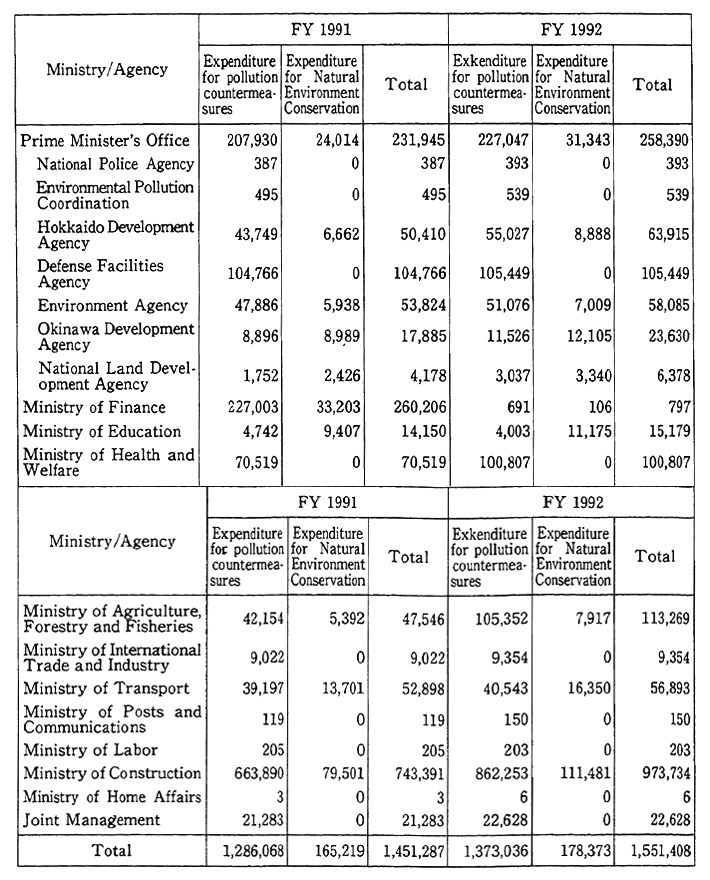
Remarks : 1. Surveyed by the Environment Agency.
2. The expenditures which are allocated under implementation programs are excluded.
3. As the first dight of each figure is rounded to the nearest number the figures thus rounded do not necessarily add up to the figures shown in "Total."
The expenditures for anti-pollution projects by institutions for which financial loans and investments were available came to ¥1,958.1 billion in the initial programs for fiscal 1992, up 107.1 billion from the 1, 851 billion earmarked for the initial programs for fiscal 1992.
5-2-2 Environmental Conservation -Related Budgets
The budgets related to environmental conservation in fiscal 1992 were executed on a priority basis particularly for the following items with a view to promoting environmental administration.
(1) Development of Various Standards, Etc.
¥1,137,000,000 was earmarked for the development of environ- mental quality standards and emission standards.
(2) Strengthening of Surveillance and Control
¥5,990,760,000 was earmarked for surveillance and control over air pollution, water pollution and so forth. The major items are as follows:
Facilities for Facilities for Pollution Monitoring ¥828,850,000
Measures for Insuring the Safety of Chemicals ¥1,015,240,000
Water Pollution Prevention Measures ¥439,450,000
Air Pollution Prevention Measures ¥299,430,000
(3) Subsidization of Environmental Pollution Prevention Projects
To encourage the installation by private corporations of pollution prevention facilities, an aggregate total of ¥9,437,380,000 was earmar- ked. Broken down, the main items areas follows:
Expenditure Associated with Projects for Construction and Sale by Japan Environment Corporation ¥4,354,830,000
Measures for Conservation of the Environment of Fishing Grounds ¥1,182,750,000
(4) Promotion of Environmental Pollution-Related Public Works Projects, Etc.
To promote environmental pollution-related public works pro- jects, etc., an aggregate total of ¥82,353,250,000 was earmarked. Broken down, the main items are as follows:
Sewage Projects ¥918,330,000,000
Measures for Noise Prevention of Schools, Houses,etc. ¥2,541,580,000
Redevelopment of Waste Treatment Facilities ¥108,376,330,000
Farming Hamlet Drainage Projects ¥83,934,000,000
Measures Against Land Subsidence ¥10,766,000,000
Green Buffer Zone Projects ¥4,036,000,000
Construction for Mine Pollution Prevention at ¥3,072,150,000
Shut Down or Abandoned Mines
(5) Promotion of Surveys and Studies of Environmental Pollution Prevention
To strengthen surveys and studies of environmental conservation, an aggregate total of ¥30,490.8 million was earmarked. Broken down, the main items are as follows:
Expenditure for National Institute for Environment Studies ¥5,910,230,000
Tests and Studies on prevention of Environmental Pollution, Etc., by National Institutions ¥1,918,040,000
Comprehensive Promotion of Studies on the Global Environment ¥1,900,000,000
Study and Development of New Energy Technologies ¥690,840,000
Surveys and Studies for Pollution Prevention of Environmental Pollution ¥1,335,300,000
Grants-in-Aid for Scientific Research Outlays ¥560,000,000
(6) Replenishment of Funds Established for Protection of Environ mental Pollution Sufferers, Etc.
To replenish funds used for protective measures for suffers from environmental pollution, an aggregate total of ¥24,807,420,000 was earmarked. Broken down, the main items are as follows:
Costs, Such as Payment of Indemnities to Suffers from Environmental Pollution ¥23,298,400,0000
Costs for Arbitration in Disputes over Environmental Pollution ¥539,370,000
(7) Promotion of Measures for Nature Protection
To work for the conservation of the natural environment, ¥178, 372,680,000 was earmarked. Broken down, the main items are as fol- lows:
Costs for the management of national and quasi-national parks, etc., for development of facilities ¥6,592,240,000
Expenditure for park projects ¥12,366,005,000
Expenditure for projects to redevelop the environmentals seacoasts, ports and harbors ¥24,612,980,000
Outlays to purchase historic relics ¥10,176,270,000
(8) Others
In addition, ¥16,819,1.80,000 was earmarked for carbon dioxide fixation, for effective utilization (¥3,217,280,000) and other measures.
5-2-3 Financial Loans and Investments
Financial loans and investments are used by government related institutions, such as the Environmental Pollution Control Service Corpo- ration, Japan Development Bank, Hokkaido and Tohoku Development Corporation, Environmental Hygiene Finance Corporation, Smaller Business Finance Corporation, People's Finance Corporation, Small Business Promotion Corporation, Agriculture, Forestry and Fishery Finance Corporation, Metal and Mining Industries Corporation and Okinawa Development Finance Corporation, to subsidize private businesses, among others, to invest in facilities against environmental pollution. They are also used to promote the improvement, etc., of sewage projects by local governments, with measures for financial sources under local-bond programs.
5-2-4 Tax Measures on Loans and Subsidies for Environmental Pollution, Etc.
To promote environmental pollution prevention measures by private institutions, subsidization and tax measures are being im- plemented by the Environmental Pollution Control Service Corporation and other organizations.
(1) Subsidization by Japan Environment Corporation (JEC)
a. JEC's Lines of Administrative Work
Since its establishment in 1965 the Japan Environment Corpora- tion has performed administrative work on construction and sale, on loans to prevent environmental pollution. and or overneas environmen- tal information service
(a) Construction and Sales
The JEC accepts applications from entrepreneurs. If approved, the JEC builds facilities such as (1) group installation of buildings, (2) facilities of multiple benefit to the public (buffer green zones and park facilities), (3) green zones against air pollution, (4) green zones facilities of undustrial waste (5) facilities at national and quasi-national parks and Upon completion of those facilities, the Corporation sells them to the entrepreneurs at cost with long-term repayment, at low interest rates.
(b) Loans
The Japan Environment Corporation also advances funds for projects, such as (1) facilities for the prevention of industrial pollution and (2) the prevention of soil pollution in developed areas, and (3) the installation of combined septic tanks.
(c) Overseas Environment Information Service
With a view to assisting developing areas in conserving environ- ment, the overseas environment information service will provide the agencies at home and abroad with information and klowhow concerning pollution control technologies, etc., accumulated at the Japan Environ- ment Corporation after selecting such information and knowhow as may help developing areas in conserving environment.
b. Projects in Fiscal 1992
The projects those which are to be undertaken in fiscal 1992 are as follows:
Projects for fiscal 1992 (amount of new contracts) ¥89 billion
(Including ¥54 billion for construction and sale projects and ¥35 billion for loan projects)
(2) Loans by Other Government Institutions
Other government institutions also subsidize pollution prevention, depending on their respective characteristics.
a. Loans Under Funding for Modernization of Medium and Small Business Facilities
As part of the system of funding the modernization of medium and small business facilities, loans are advanced to individual medium and small businesses through prefectural governments for the installa- tion of facilities to prevent pollution. For the proprietors of small business, a system is in effect whereby the lending institutions estab- lished by prefectural governments can lend facilities to those proprie- tors.
b. Loans are extended by Smaller Business Corporation, People's Finance Corporation and Okinawa Development Finance Corporation, and Special loans are available for the relocation of small and medium businesses.
c. Loans by Smaller Business Finance Corporation As part of the system of development loans by the Smaller Business Finance Corporation, loans are provided for projects to group factories in order to eliminate residence-cum-factory facilities and for projects in which multi-user treatment facilities will be established for pollution prevention.
d. Loans by the Japan Development Bank
The Japan Development Bank has extended loans for the modifi- cation of facilities for environmental protection.
e. Loans by the Hokkaido and Tohoku Development Finance Corporation
The Hokkaido and Tohoku Finance Corporation lent funds for the modification of facilities to prevent pollution in the Hokkaido and Tohoku regions.
f. Loans by the Agriculture, Forestry and Fisheries Finance Corporation
The Agriculture, Forestry and Fisheries Finance Corporation advanced funds for the installation of cattle feces treatment facilities, etc., using a loan framework of Y1.1 billion.
g. Loans by the Metal and Mining Industries Corporation
The Metal and Mining Industries Corporation advanced loans for projects to prevent mine pollution and loans for the shares of entrepre- neurs under the Law Concerning Entrepreneurs' Bearing of the Cost of the Public Pollution Control Works by taking advantage of a loan framework of Y2.4 billion.
(3) Tax Measures
a. National Taxes
(a) Tax credit or special depreciation measures were instituted where diesel-engined buses or trucks under the 1979 regulations are replaced by those meeting the latest nitrogen oxide exhaust regulations.
(b) The special depreciation measures earlier adopted that are con- cerned with equipment to control and collect the specified CFCs were extended.
(c) The special tax treatment measures were expanded, such as the addition to the items entitled to special tax credit for capital gains from the ownership transfer of land etc. for businesses provided for under a system newly instituted by the Japan Environment Croporation.
(d) The measures earlier put into effect for a reduction of the Registration and License Taxes were extended for the registration of ownership transfers where business cooperative associations, ect. re- transfer to their members, etc. land tracts originally acquired from the Japan Environment Corpomation.
(e) The special tax credit measures previously put into force were extended for equipment to prevent noises, control nitrogen oxide exhaust, process some specified types of dust, and process industrial wastes, and new measures for tax credit or special depreciation were adopted for desulfurization plants for light oil.
(f) The expiration of application of special depreciation measures to waste plastics recycling equipment was extended.
(g) The expiration of application of special depreciation measures to recycling plants of waste pavement materials was extended; and, at the same time, recycling equipment of waste concrete and waste wood materials from construction works was added to the items entitled to special depreciation measures.
b. Local Taxes
(a) Measures ot reduce the Automobile Tax and Automobile Acquisi- tion Tax were adopted for the replacement of diesel-engined trucks and buses meeting the 1979 nitrogen oxide exhaust standards with vehicles meeting the latest nitrogen oxide exhaust standards.
(b) Measures were adopted for a reduction of the Automobile Acqui- sition Tax for vehicles which meet the 1993 nitrogen oxide exhaust standards.
(c) Measures were adopted for a reduction of the Automobile Tax and Automobile Acquisition Tax for hybrid vehicles, and the measures for the reduction of the Automobile Tax and Automobile Acquisition Tax for methanol vehicles were extended.
(d) Measures for a reduction of the Fixed Asset Tax were adopted for equipment to remove ink from waste paper, that to select and press empty cans and that to remove materials other than glass from waste glass.
(e) The measures earlier adopted for the reduction of the Fixed Asset Tax for waste plastics recycling equipment and pavement mate- rial recycling equipment were extended ; and, equipment to recycle waste concrete and wood materials from construction works was added to the items entitled to the reduction.
(f) Measures for a reduction of the Business Establishment Tax were adopted for facilities put in use for businesses of registered waste recycling agents.
(g) The special tax treatment measures were expanded, such as the addition to the items entitled to the exemption from the Business Establishment Tax the transfers of land etc. where individuals transfer the ownership of land etc. to the Japan Environment Corpomation for businesses of the corporation, with the institution of the new projects for construction and sale by the said corporation.
(h) The special tax treatment measures previously put into force were extended for the Real Estate Acquisition Tax as for buildings transferred from the Japan Environment Corporation after a review of the measures against abrupt changes of economic condition with respect to the tax base.
(i) The measures earlier adopted to exempt the Business Establish- ment Tax as to buildings transferred from the Japan Environment Corporation for the purpose of grouping were extended.
(j) The measures previously put into effect to exempt the Fixed Asset Tax were extended for waste water or waste liquid processing facilities, waste processing facilities and final processing grounds of general wastes. processing facilities of certain industrial wastes, nitro- gen oxide exhaust controlling equipment, soot processing facilities, and processing facilities of certain specified kinds of dust
(k) The measures previously adopted of reducing the Fixed Asset Tax were extended fro molding sand recycling facilities, general dust processing facilities, tall chimneys, waste water processing facilities of which those designated by the Law Conderning Special Measures for Conservation of the Lake Water Quality, processing facilities of cerfain industrial wasten and noise prevention equipment.
(1) The measures earlier put into effect to reduce the Fixed Asset Tax and to exempt the Special Land Ownership Tax and Business Establishment Tax were extended for facilities to convert water into industrial water.
5-2-5 Sharing by Entrepreneurs of Environmental Pollution Prevention Project Outlays
In situations where the State or local governments are to carry out projects for the prevention of pollution, as those projects are necessitated due to the business performance of entrepreneurs, the Law Concerning Entrepreneurs' Bearing of the Cost of Public Pollution Control Works calls for them to share costs for environmental pollution prevention projects, depending on the degrees of the causes.
As of the end of March 1993, the status of environmental pollu- tion prevention projects, to which the Law Concerning Entrepreneurs' Bearing of the Cost of Public Pollution Control Works had been applied (since its enactment in May 1971), is shown in Table 5-2-2.
Table 5-2-2 Shares of Cost Burdens for Pollution Prevention Projects by Entrepreneurs
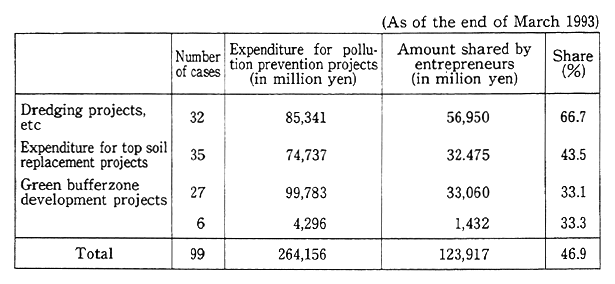
Remarks: 1. Surveyed by the Environment Agency.
2. As there are projects in which dredging projects, etc., are conducted along with green buffer zone projects, the number of project-specific cases does not agree with the total of cases.
3. The expenditure for pollution prevention projects and the total of costs burdened by entrepreneurs are on a plan basis.
5-3 Environmental Impacts Assessment
5-3-1 Environmental Impacts Assessment
The environmental impacts assessment is designed to make full surveys, prediction and assessment in advance on possible environmen- tal impacts which may arise from the execution of projects, release the findings and listen to the views of community residents and so forth so that environmental conservation measures may be implemented to the full. It is an effective means to prevent environmental pollution.
In Japan, the environmental impacts assessment has been perf or- med under the Public Waters Reclamation Law and other individual laws, administrative guidance by ministries and agencies, ordinances and operating procedures of local governments, etc., since the Cabinet approved "On the Environmental Conservation Measures Relating to Public Works" in June 1972.
Furthermore, the Cabinet approved "Implementation of Environ- mental Impact Assessment" in August 1984 and formulated the "Outline for the Implementation of Environmental Impact Assessment" as a uniform rule for large-scale projects in which the State would be involved.
In summary, the applicable projects include those which are large scale and likely to produce significant impacts, provided that they are those which are conducted by the State or in which it is involved, such as in permitting. They include spatial development projects, such as roads, dams, railways, airports, land reclamation, inning and land zoning adjustment projects.
Fig. 5-3-1 Flow of Procedures in Outline for Implementation of Environmental Impact Assessment
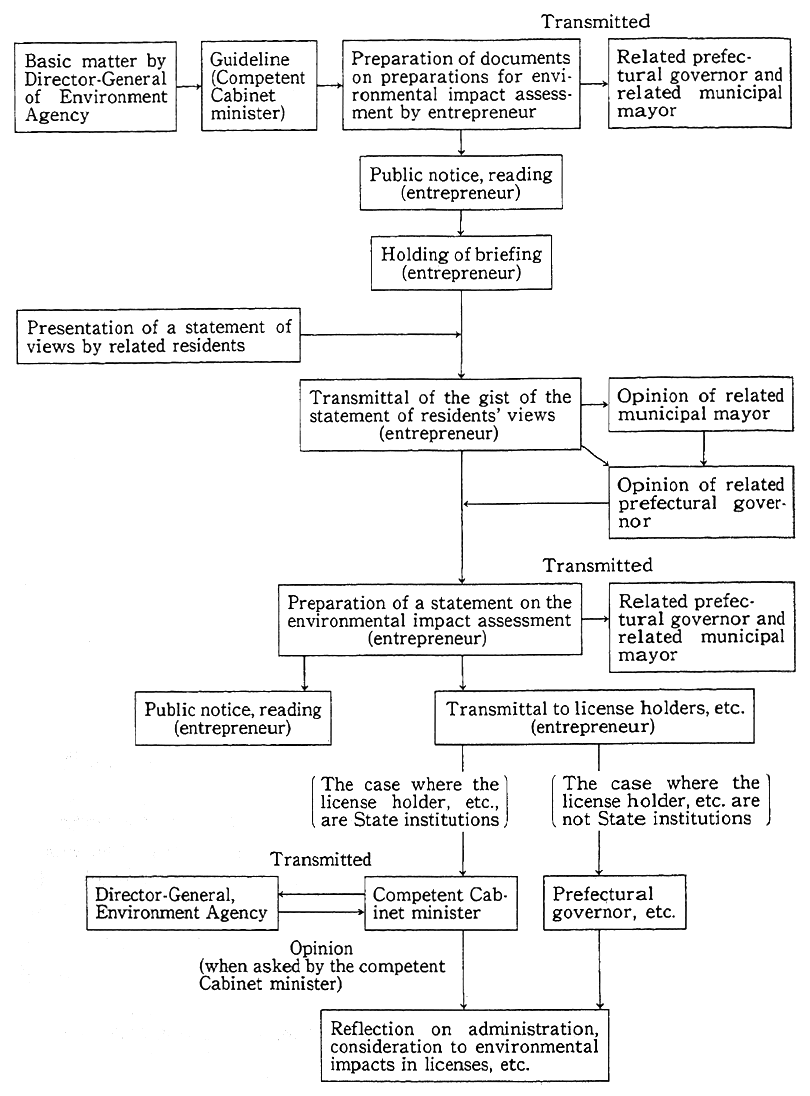
A summary of procedures taken by project-undertakers is given below: (See also Fig. 5-3-1)
(A) In regard to the impacts that are brought about by the projects, project-undertakers shall make prior surveys, estimate and assess in accordance with the guideline formulated upon consultation between the concerned ministers and the Director-General of the Environment Agency. They shall then come out with a preparatory draft environmental impacts statement (hereinafter referred to as "draft EIS").
(B) Project-undertakers shall serve public notice on, and send out the draft EIS and shall hold briefings.
(C) Project-undertakers shall strive to understand the views of residents in the relevant areas on the draft EIS. They shall call on the governor of the affected prefectures to express their views after listening to the views of the mayors of the related municipalities.
(D) After listening to those views, project-undertakers shall review the descriptions contained in the draft EIS, prepare a final environmental impacts statement (hereinafter referred to as "final ELS"), serve public notice on, and distribute the statement.
It is stipulated that administrative agencies shall take account of environmental impacts on the final EIS in the licensing of subject projects and other cases. It is also stimulated that the competent minister shall listen to the views of the Director-General of the Environ- ment Agency, if deemed necessary.
In 1992, there were 23 assessments of environmental impacts for which the procedures were completed in accordance with the afore- mentioned outline. (Table 5-3-1)
Table 5-3-1 Breakdown of Environmental Impacts Assessments Made According to Cabinet Decisions (1992)

Remarks: The figures in parentheses represent the aggregates as of the end of 1992.
5-3-2 Environmental Impacts Assessment Under Individual Laws
The outline of the assessments of environmental impacts made in fiscal year 1992 under the Port and Harbor Law and the Public Waters Reclamation Law, among others, is given below:
(A) Port and Harbor Plans
The port and harbor plans formulated under the Port and Harbor Law are essential for the development, utilization and conservation of ports and harbors. In preparation of these plans, environmental impacts are assessed. In fiscal 1992, the port and harbor plans formulated for Tokyo, Tokuyama-Shimomatsu and other ports were adjusted based on their impact statement.
(B) Reclamation of Public Waters
It is stipulated that possible impacts on the environment shall be checked in advance to the licensing of reclamation under the Public Waters Reclamation Law. For reclamation in excess of 50 hectares and reclamation in need of special consideration to environmental conserva- tion, it is stipulated that the competent minister must listen to the views of the Director General of the Environment Agency. In fiscal year 1992, reclamation at Chujo-Bay New port Area in Okinawa Prefecture and other ports was studied and the Director General of the Environment Agency set forth his views.
(C) Location of Power Generation Plants
For the location of power generation plants, environmental impacts are assessed under the administrative guidance of the Ministry of International Trade and Industry, and studies are also made on environmental conservation during the course of deliberations at the Electric Sources Development Council. In fiscal year 1992, the programs for the Yokohama thermal power beneration plant and Yanazu- Nishiyama geothermal power etc. were modified based on impact statement.
(D) Others
1) City Planning for Urbanization Promotion Areas
As regards city planning for urbanization promotion areas under the City Planning Law, it is stipulated that the views of the Director- General of the Environment Agency shall be sought in advance.
2) In formulating basic concepts and implementing projects under the Comprehensive Resort Areas Development Law, it is stipulated that studies shall be made in a perspective of environmental conservation, depending on the substance, and that the compete minister shall discuss with the Director General of the Environment Agency in approving of the basic concepts. Necessary adjustments were made to the basic concepts of five prefectures in fiscal year 1992.
5-3-3 Environmental Impacts Assessment in Local Government
Local governments also have the environmental impacts assess- ment system, under ordinances or general plants. (Table 5-3-2).
Table 5-3-2 Enactment of Ordinances and Outlines on Environmental Assessments
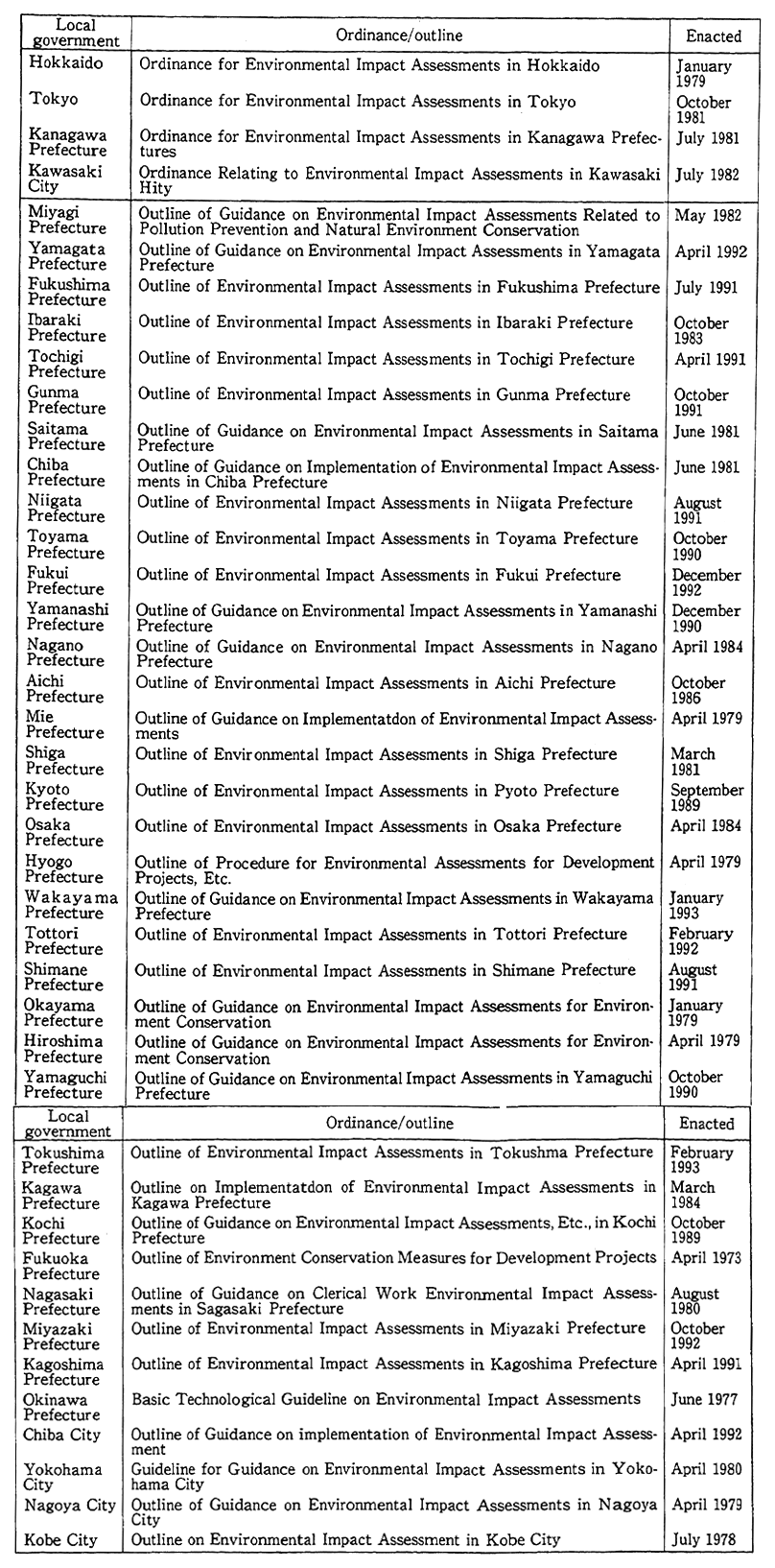
5-4 Community-Oriented Environmental Conservation
5-4-1 Environmental Management
There is the need not only to prevent environmental pollution now but also to conserve and use environmental resources, such as water, air, soil and forests, for the building of a better environment. For this, it is essential, after making clear the desirable objective for the global environment, to promote management of the global environment with the comprehensive and systematic implementation of a variety of measures.
Progress in the formulation and evaluation of regional environ- mental control programs for that purpose is being made by many local governments. The Environment Agency is providing those local govern- ments with guidance and advice on the formulation and smooth imple- mentation of the programs. The agency also subsidizes prefectures which streamline information about environmental resources and for- mulate guidelines for local development with consideration given to the environment and local development programs with the effective use of environmental resources.
In the Nation's Capital Region and other major urban areas, the environmental conditions are unfavorable, and calls by residents for a more comfortable environment are growing further. In the midst of moves for a boost in domestic demand, many large scale projects are planned, thus making it necessary to promote inter-jurisdictional envi- ronment controls. Having promoted studies on the way inter- jurisdictional environmental controls ought to be in major urban areas, the Environment Agency conducted surveys and evaluations, centering on the Kinki and Chubu areas in fiscal 1992.
There is a need to redevelop the Osaka bay area so as to recreate good quality living environment in the area. For this purpose, enacted in December 1992 was the Osaka Bay Area Development Law, which stipulates that the prefectures concerned formulate and implement comprehensive plans. To addres this, the Environment Agency conduct- ed studies and surveys on environmental conservation of the area.
On the other hand, it is important for each person to recognize the present state of environmental issues and the importance of conserving the environment and to step up actions in their everyday lives which will contribute to environmental conservation. For this purpose, in 1989 a fund for conservation of the local environment was established in each of the prefectures and cities designed by administrative ordinance to carry out projects for the dissemination and enhancement of knowledge about local conservation. In fiscal 1992, video tapes, slides and other aids were prepared, and symposia and festivals were held.
Then, there are mounting calls for the utilization of vacant underground space for public purposes. In this vein, there is concern about the impacts of underground space on land subsidence and on hot spring sources. To address this, the Environment Agency is conducting studies at the Investigative Meeting Concerning Environmental Man- agement of the Ground and Underground Development.
5-4-2 Building of Comfortable Communities sensitive to the Environment
Green and clean riverbanks, beautiful streets, historic atmo- spheres and other comfortable amenities bring about charm and peace of mind. With the people's environmental needs in the process of becoming more sophisticated, there is the need to create a comfortable environment. There is a wide variety of measures for the building of a comfortable environment, including those enumerated below:
(A) Modification of facilities to improve communion with nature,
(B) Conservation of the good state of the natural world, (such as forests and watersides), .around us
(C) Creation of comfortable urban and living space, such as the scenes of roads and streets
(D) Measures for the assurance of rules of social behavior with attention focused on the environment
(E) Preservation of historic and cultural assets with which to enhance the quality of the environment
In conjunction with a symposium in October 1992, the Environ- ment Agency for the third time gave letters of commendation to local governments excellent at the building of communities full of amenities
5-5 Pollution Prevention Programs
5-5-1 Outline of Pollution Prevention Programs
(1) Present Status of Pollution Prevention Programs
For areas with significant environmental pollution, pollution prevention programs are prepared by the governors of the related prefectures under the Basic Law for Environmental Pollution Control, directed by the Prime Minister, and endorsed by the Prime Minister to comprehensively promote the projects and measures of entrepreneurs and local governments for the prevention of environmental pollution. By now, environmental pollution prevention programs have been formulat- ed for 34 areas, covering principal industrial cities and major cities across the nation.
The rates of those cities to all cities in the nation stand at about 59% in terms of area and about 62% in terms of the amounts of products shipped out and so forth.
For Tokyo and eleven other areas for which the program term expired as of the end of fiscal 1991, new environmental pollution prevention programs were formulated. (Tables 5-5-1, Figure 5-5-1)
Table 5-5-1 Formulation of Pollution Prexention Programs
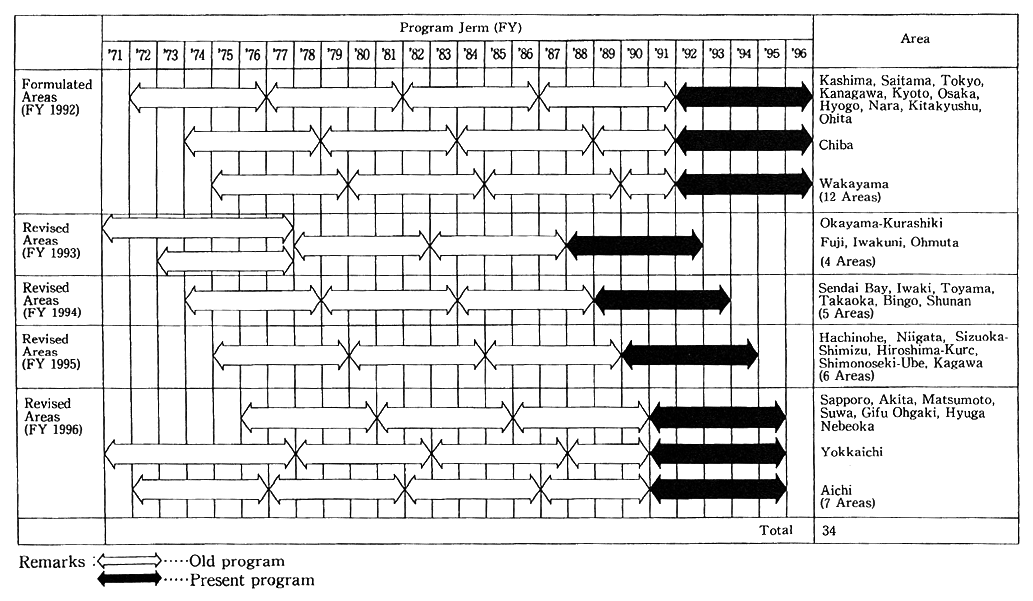
Fig. 5-5-1 Areas With Pollution Prevention Programs Formulated (Present Programs)
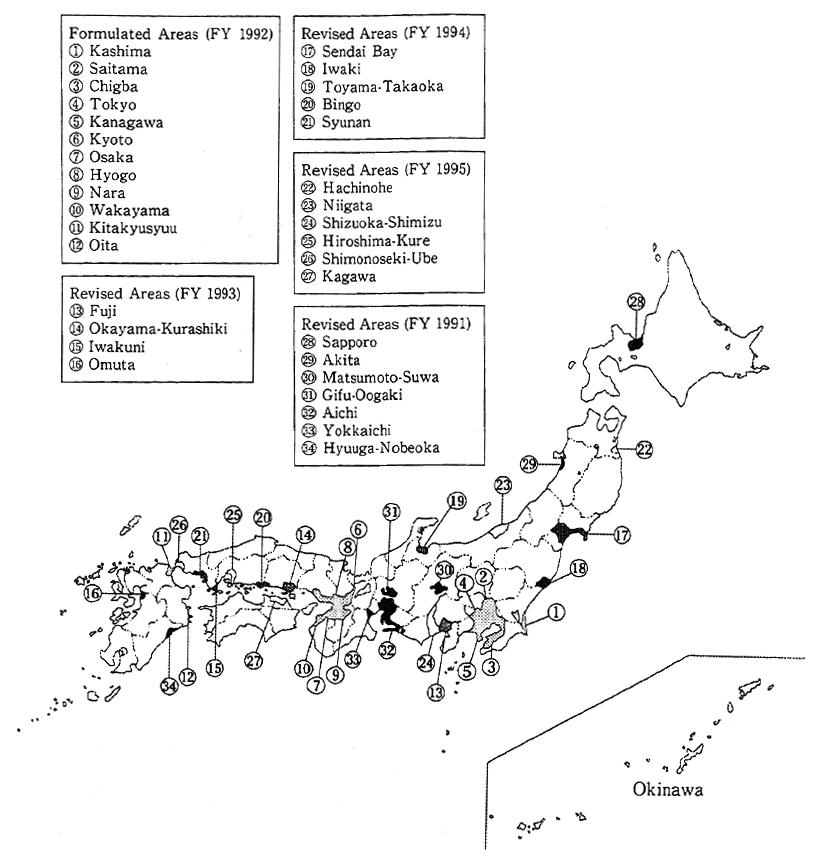
5-5-2 Formulation of Pollution Prevention Programs in Fiscal 1992
For Tokyo and eleven other areas for which the program term expired as of the end of fiscal 1991, the Prime Minister instructed the governors of the related prefectures to formulate pollution prevention programs, and they prepared pollution prevention programs in accor- dance with the basic policy associated with each area. On March 11, 1993, the Prime Minister approved the environmental pollution preven- tion program prepared for each area. (Table 5-5-2). The gist is as follows:
Table 5-5-2 Areas with Pollution Prevention Programs and Their Scope
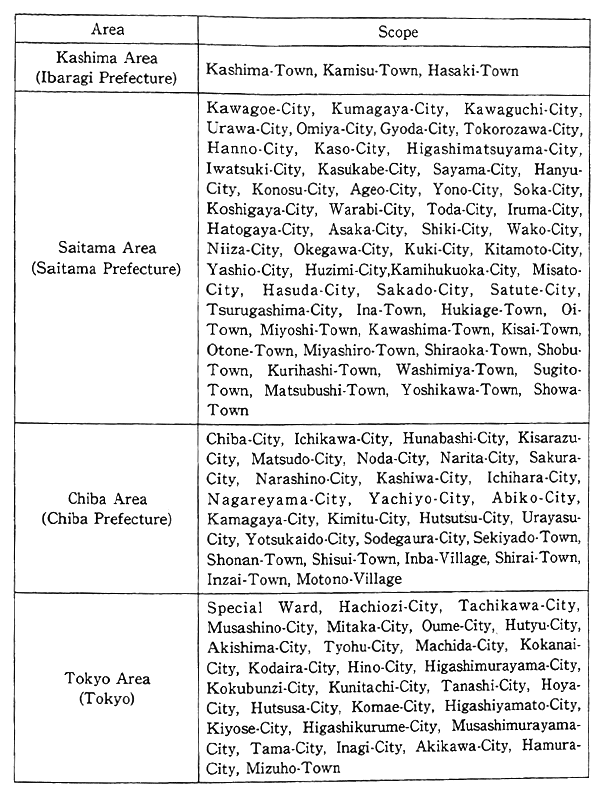
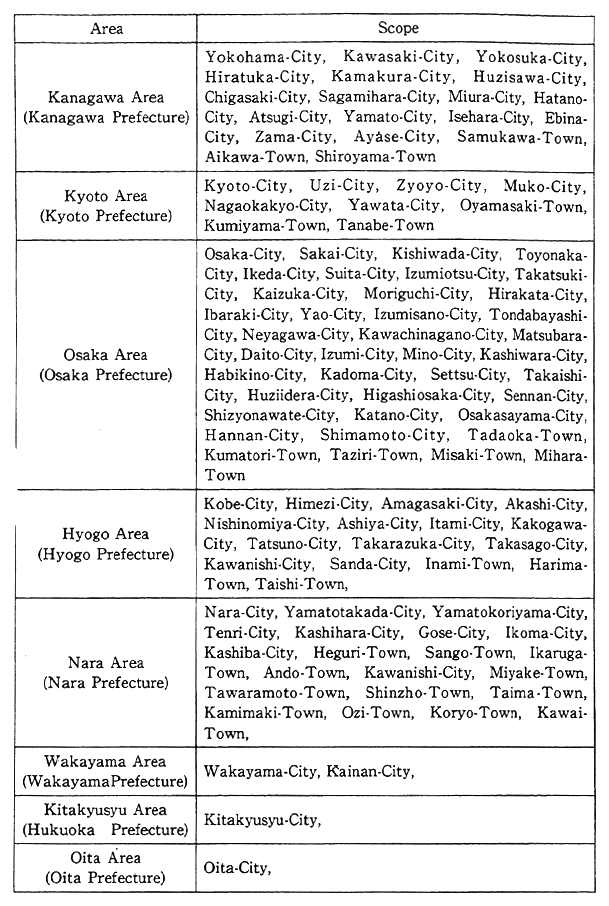
(A) Scope of Areas
The twelve areas are shown in Table 5-5-3.
(B) Purpose of Program
The target of each program is to achieve environmental quality standards, and it is stipulated that efforts shall be made to accomplish the purpose as a whole by the end of the program term with the promotion of a variety of measures for the prevention of environmental pollution.
(C) Program Term
The program is set at five years from fiscal 1992 to 1996.
(D) Measures for Prevention of Environmental Pollution
It is stipulated that entrepreneurs shall take measures for the prevention of pollution. It is also stipulated that local governments and so forth shall promote countermeasures to pollution such as controls on environmental pollution and environmental assessments; the improve- ment of sewage systems; that of waste treatment facilities, etc.
(E) Outline of Costs
For the implementation of those measures for the prevention of pollution, it is estimated that when it comes to the estimated costs required for those areas during the program term, the measures which are to be taken by entrepreneurs will require ¥1,032.4 billion, those which are to be taken by local governments will require ¥8,712.3 billion and those for pollution-related projects will require ¥4,022.3 billion.
5-5-3 Present Status of Implementation of Pollution Prevention Programs
(1) Implementation of Pollution Prevention Program Projects
As indicated in Table 5-5-3, each local government promotes projects for the prevention of environmental pollution.
Table 5-5-3 Implementation of Pollution Prevention Programs
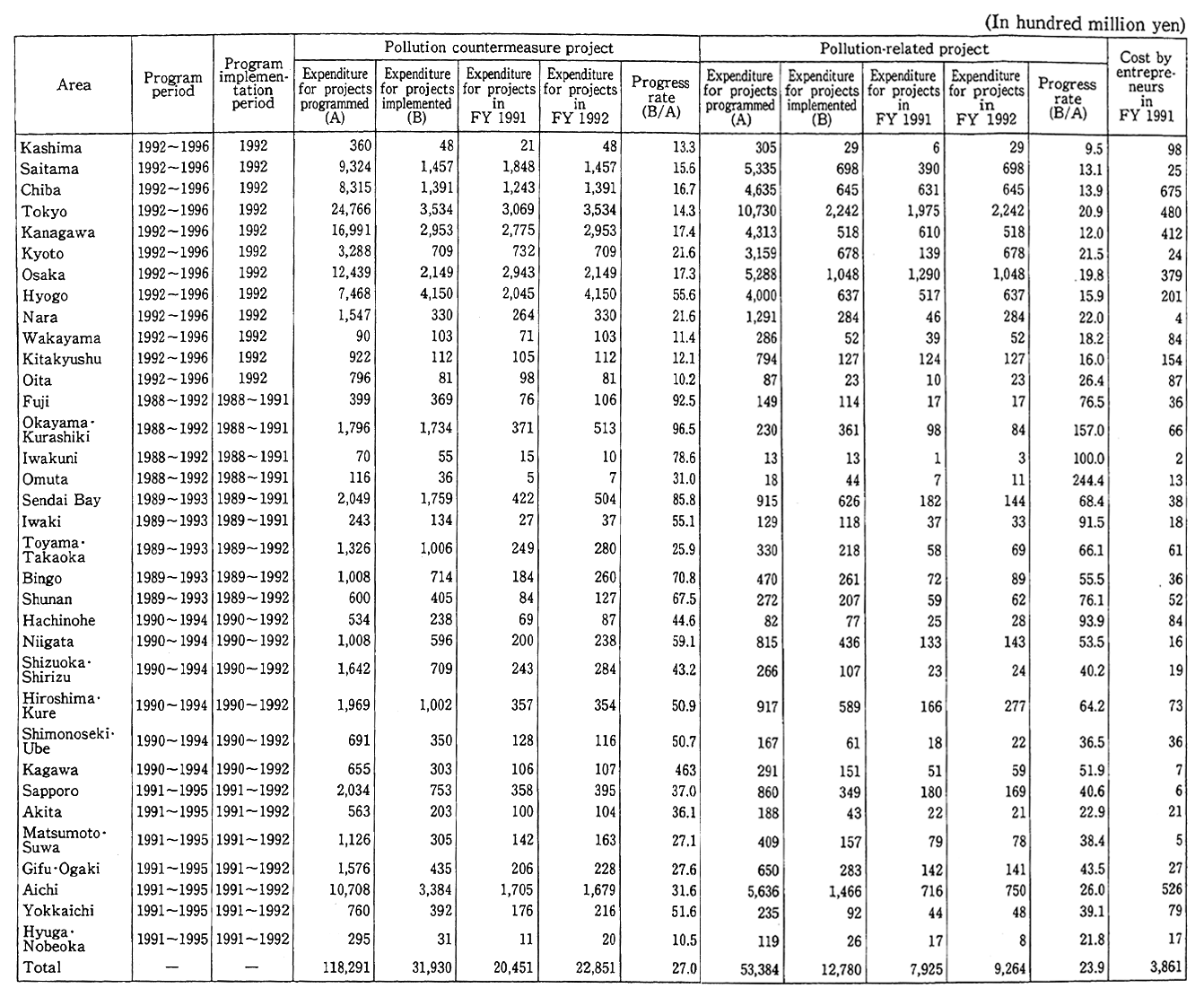
(2) Special Financial Measures for Environmental Pollution Prevention Projects under the Law Concerning State's Special Financial Measures for Pollution Prevention Projects
For pollution prevention projects which are to be carried out by local governments under pollution prevention programs, special national fiscal measures are implemented, such as increases in the state' s shares and subsidization rates and the broadening of projects for which local bonds are available. The outlays for environmental pollu- tion projects and the increases in the state's shares and subsidization rates in the last five years are given in Table 5-5-4.
Table 5-5-4 Project Expenditure Associated with Pollution Prevention and State Burdens or Amounts of Subsidies Raised
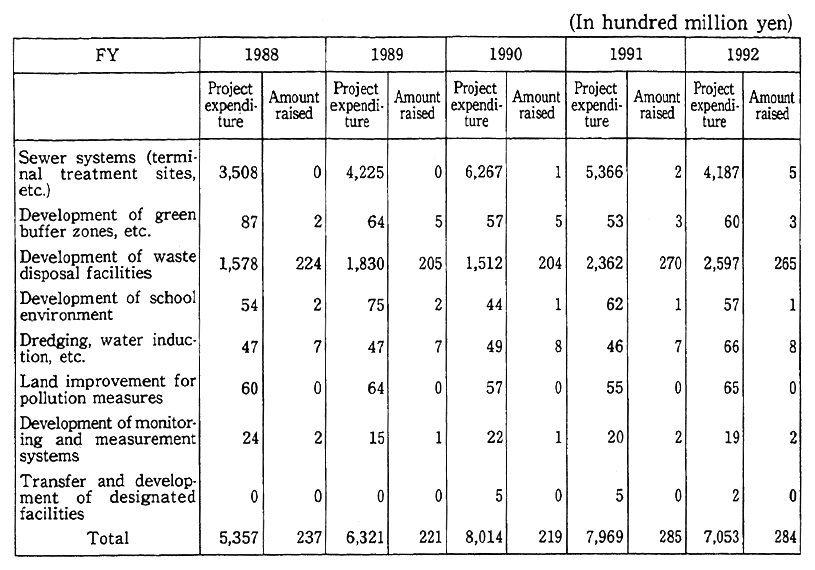
Remarks:1. Surveyed by the Environment Agency
2. The amounts of the project expenditures and the amounts raised were those projjected for FY 1992.
(3) Environmental Quality in Areas with Established Pollution Prevention Programs
By the promotion of various pollution prevention programs, the environmental quality in areas where pollution prevention programs are formulated is as follows:
The rate of monitoring stations which met the environmental quality standards of sulfur dioxide (the number of environmental quality standards achieving monitoring stations/total number of effective monitoring stations) stood at 100% in fiscal 1991.
Data on nitrogen dioxide, checked in terms of environmental quality standards, are indicated in Table 5-5-5. In fiscal 1991, the percentage of monitoring in excess of 0.06 ppm, (the borderline of the environmental quality standards) stood at 10.6%.
Table 5-5-5 Environmental Standards for Nitrogen Dioxide and Responses in Pollution Prevention Program Areas (General Stations)

Remarks : 1. Surveyed by the Environment Agency.
2. Monitoring stations whose values are less than the effective monitoring hours are excluded.
3. Zaruzman's coefficient=O.84
As for suspended particulate, data are shown in Table 5-5-6. The rate of monitoring stations meeting the standard came to 31.0% in fiscal 1991.
Table 5-5-6 Achievement of Environmental Standards for Suspended Particulate Matter in Pollution Prevention Program Area (General Stations)

Remarks : 1. Surveyed the Environment Agency.
2. The monitoring stations which have not reached effective monitoring hours are excluded.
When it comes to photochemical oxidants, the number of monitoring stations reporting compliance with environmental quality standards (below 0.06 ppm in terms of hourly values) accounted for four of 687 monitoring stations in all. The number of monitoring stations which observed values in excess of the standard concentration for the issue of warnings (0.12 ppm in terms of hourly values) was 311 out of 687 monitoring stations.
As regards the water quality of rivers, lakes, marshes and seas, the status of compliance with environmental quality standards for BOD and COD is shown in Table 5-5-7.
Table 5-5-7 Achievement of Environmental Standards for Rixers, etc, in Pollution Prevention Program Area (General Stations)
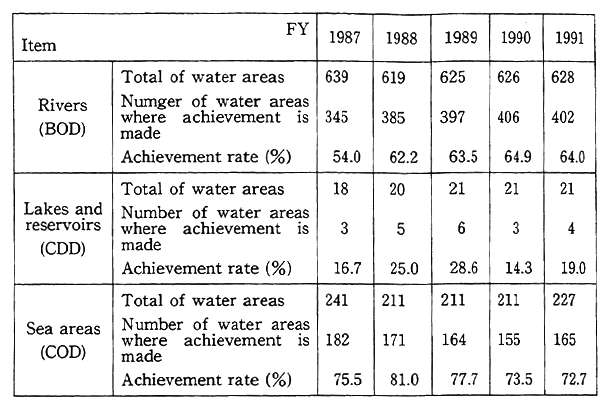
Remarks : Surveyed by the Environment Agency
(4) Implementation of Environmental Pollution Prevention Projects Designated by the Minister of Home Affairs
Some projects for pollution prevention in areas other than those for which pollution prevention programs are formulated, are designated by the Minister of Home Affairs. When it comes to those areas, special financial measure are implemented as is the case with the pollution prevention projects which are based on pollution prevention programs. The pollution prevention programs that have been specified in the last five years are indicated in Table 5-5-8.
Table 5-5-8 Environment Pollution Prevention Projects Designated by Minister of Home Affairs
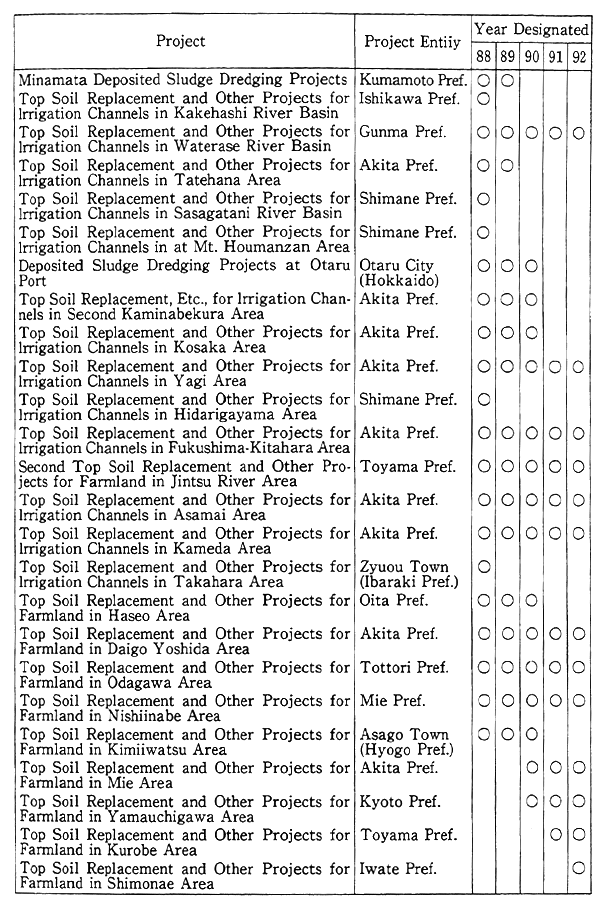
Note: By fiscal 1987, 37 projects hai been completed.
5-6 Environmental Conservation Measures for High Technology Industries
In recent years, there has been much progress in the development of so-called high technology, including microelectronics, new materials and biotechnology. High technology development also means the possi- bility of new types of environmental pollution from the perspective of emission sources, emission forms and various impacts. In the industrial use of high technology, there is a need to intensively study possible environmental impacts, thereby preventing environmental pollution beforehand, and also applying achievements in high technology to issues of environmental conservation.
5-6-1 High Technology and Environment
The Environment Agency published the Report of the Environ- mental Technology Council in April 1987, thus laying out the basic direction for environmental conservation to deal with the evolution of high technology. Besides, environmental technological information in the IC sector was released, and the Fact Finding Survey on the IC industry (fiscal 1986) was conducted under the co-sponsorship of the Environment Agency, Ministry of Health and Welfare,Ministry of Inter- national Trade and Industry and Ministry of Labor. Also in the sector of new materials, the guidebook related to environmental protection for engineering plastics was published in December 1989.
5-6-2 Biotechnology and Environment
As the industrial use of biotechnology develops in recent years, studies are being performed both at home and abroad for the assurance of safety in industrial use.
In Japan, related ministries and agencies released guidelines for the industrial use of recombinant DNA technology, and recombinant DNA in closed system has been developed. As for the release of recom- binant DNA into the environment, field experiments are performed in the United States and other countries, and especially cultivation of recombinant plants are performed in open environment. For the assur- ance of safety, the Science and Technology Agency amended the Operation of the Guideline for Recombinant DNA Experiments in December 1988, thus presenting a concept about experiments in the non-closed system, with the use of plants, and on the basis of this guideline, field experiments have been conducted. Also on the basis of a guideline of the Ministry of Agriculture, Forestry and Fisheries, step-by- step safety consideration is performed for recombinant tomato in terms of ecological impacts and so forth in the field experiment. Based on the findings in the experiment, program for cultivation of recombinant tomato were approved in February 1992 and cultivation of it in open environment was begun in May 1992.
The Report of the Experts Committee on Biotechnology estab- lished in the Planning Department of the Central Council for Environ- mental Pollution Control was completed and submitted to the Planning Department in December 1991. It was pointed out in the report that it would be necessary to conduct an environmental assessment for each individual release program in relation to the environmental release of genetically modified organisms. On the basis of this report, the Environ- ment Agency develops technical matters for environmental impacts assessment, and continues to study to concrete administrative measures, while taking account of the evolution of scientific findings.
The Environmental Agency has studying monitoring of organ- isms, application of biotechnology to environment protection and so on to cope with environmental release of genetically modified organisms.
Also, the National Institute for Environmental Studies (NIES) performs researches on plants highly sensitive to photochemical smog (and other complex pollutants) by biotechnology and installed Facility for Microbial Culture Collection to preserve microbial genes which would be useful for environmental studies. In order to research applica- tion and effect of genetically modified organisms, NIES is now con- structing Biotechnology Lab oratory.
Ministry of International Trade and Industry and Ministry of Agriculture, Forestry and Fisheries began research on applocation of biotechnology in the field of environmental protection, such as environ- mentally conservative technologies for production of hydrogen.
5-7 Chemical Substances
5-7-1 Measures on Chemical Substances
(1) Controls of Chemical Substances under the Law Concerning the Examination and Regulation of Manufacture, Etc., of Chemical Substances
The prevention of environmental pollution by chemical sub- stances is done under the Law Concerning the Examination and Regula- tion of Manufacture, Etc., of Chemical Substances (hereinafter referred to as "Chemical Substances Control Law"). The Chemical Substances Control Law, enacted in 1973 and amended in 1986, is designed to perform toxicity surveys on suspected harmful substances (Designated Chemical Substances) and exercise necessary controls (for those designated as Class II Specified Chemical Substances) in addition to low biodegradable, high bioaccumulative and chronically toxic substances (Class I Specified Chemical Substances). (Fig. 5-7-1)
Fig. 5-7-1 System of Controls on Chemicals Under Chemical Substances Control Law
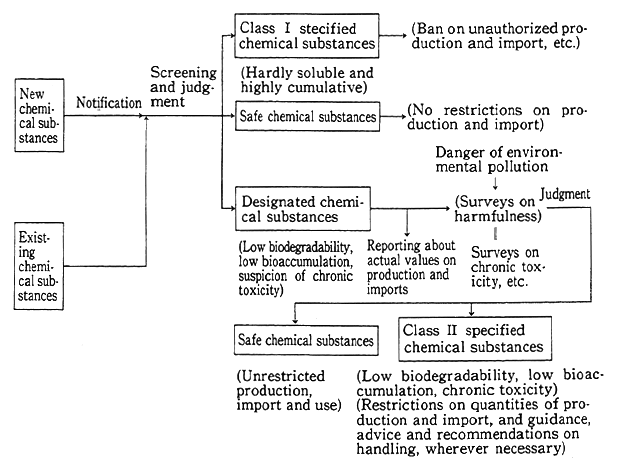
During 1992, reports were filed on 276 new chemical substances. Of those, 210 did not fall under the category of either Class I Specified Chemical Substances or Designated Chemical Substances, and 38 fell under the category of Designated Chemical Substances. As of the end of 1992, 104 new chemical substances were listed as Designated Chemical Substances.
To confirm the degree of the safety for existing chemical sub- stances, the Ministry of International Trade and Industry performed inspections and surveys on the biodegradability and bioaccumulative- ness of chemical substances, the Ministry of Health and Welfare on chronic toxicity and other matters, and the Environment Agency on the existence of chemical substances in the environment. As of December 1992, nine substances were designated in Class I Specified Chemical Substances, 23 in Class II Specified Chemical Substances and 117 as Designated Chemical Substances.
(2) General Inspection Survey of Chemical Substances on Environmental Safety
In order to efficiently and systematically survey the safety in the environment of existing chemical substances, which are said to exist in tens of thousands, the Environment Agency has performed general inspection surveys on the safety in the environment : the First General Inspection Survey starting in fiscal 1979 and the Second General Inspec- tion Survey starting in fiscal 1989. This system of general inspection survey is outlined in Fig. 5-7-2.
Fig. 5-7-2 Outline of General Inspection Survey of Chemical Substances on Environmental Safety
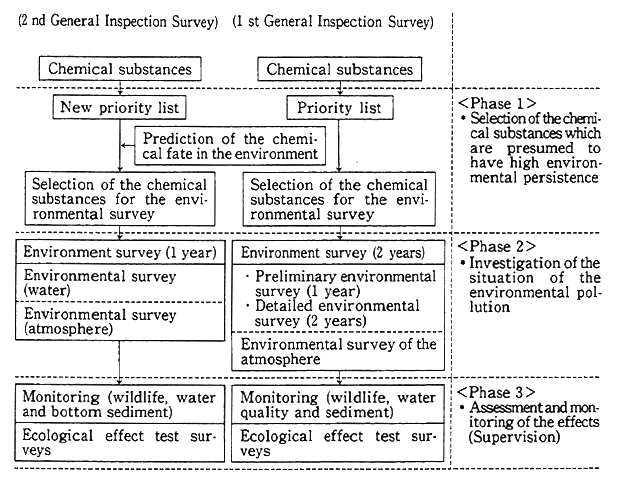
In fiscal 1992, environmental surveys on chemical substances, tests on ecological impacts, the monitoring of water and sediment quality and monitoring of organisms were conducted. In addition, related surveys and studies on the structure/activity correlations of chemical substances and other surveys and studies, the development of measures and methods for the comprehensive assessment of pollution by each environmental medium, the updating of information about environ- mental chemical substances, and comprehensive measures to be taken in accidents caused by environmental pollution.
(3) International Cooperation in Measures against Chemical Substances
International cooperation in measures against chemical sub- stances were promoted by OECD, WHO, UNEP, ILO and other interna- tional institutions in addition to positive attempts by individual coun- tries.
Japan has participated in the domestic institutionalization of the OECD-adopted GLP and performed work on the assessment for Japan of methods to assess and test ecological impacts, studies for the compre- hensive assessment of the safety of chemical substances, and collected and analyzed information about the safety of chemical substances both at home and abroad.
5-7-2 General Inspections and Surveys on Safety of Chemical substances
(1) Environmental Surveys
Environmental surveys (water system) were conducted on the water and the bottom in 55 areas across the nation and on fish in 50 areas. In 54 of them across the nation, surveys were performed on acrylamide, nitrobenzene, o-chloronitrobenzene and p-chloronitro- benzene as priority survey subjects. In addition, 18 other substances were surveyed in 10 to 19 districts. As a result, six of 24 substances, including acrylamide and nitrobenzene, were detected. Acrylamide, nitrobenzene and five other substances were detected from the bottom, and nitrobenzene, 0-nitroanisole and two other substances were detected in fish. (Table 5-7-1) The findings indicate that the frequency of detec- tion was high for N, N-dimethylforamide in water, for pyridine in bottom and fish and for triethylamine in bottom, and that the detected concentration was rather high for acrylamide in water. Though they were not immediately likely to pose questions, it was concluded that it would be important to perform environmental surveys at a certain interval and keep an eye on change in their detection.
Table 5-7-1 Results of Environmental Survey (Water) (FY 1991)
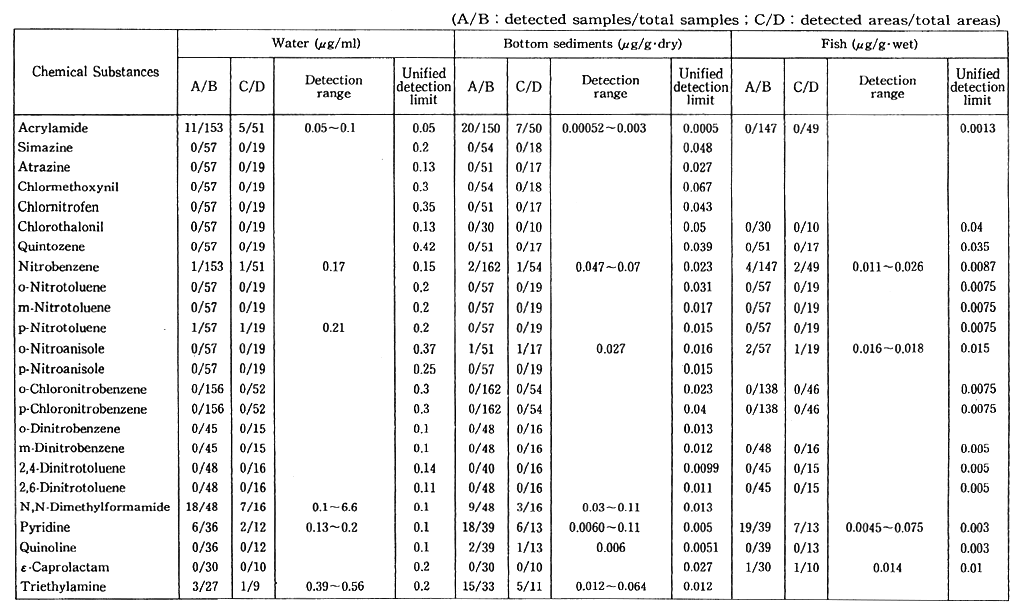
Environmental surveys on the atmosphere were conducted for 16 substances in 18 districts across the nation, and the findings were given in Table 5-7-2.
Table 5-7-2 Results of Environmental Survey (Atmosphere) (FY 1991)
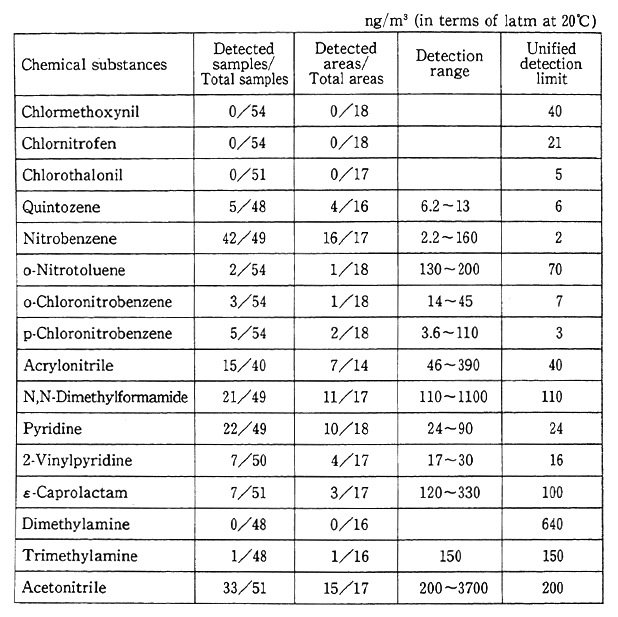
(2) Outline of GC/MS Monitoring of Water and Sediment
In fiscal 1991, the GC/MS monitoring of the water and the bottom was conducted for 20 substances in 18 districts across the nation (Table 5-7-3). As a result,fタ-HCH and five other substances were detected from the water and all of 20 substances were detected from the sediment.
Table 5-7-3 Results of the GC/MS Monitoring Concerning Water and Bottom Sediment (FY 1991)
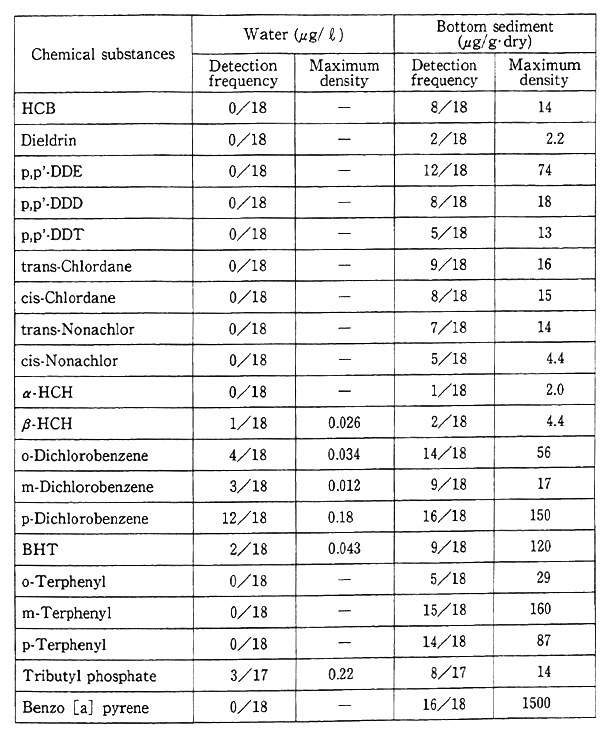
When it came to the number of substances detected from the water by survey area, no substances were detected in five areas, and the number of substances detected from the water in other areas was small as a whole with 1-3 substances. The levels of detection from the bottom was generally higher than from the water, and in terms of the highest values of each survey subject, the levels of pollution were high for closed bays.
(3) Outline of Biological Monitoring
Biological monitoring is so designed that in regard to Class I Specified Chemical Substances and chemical substances whose careful surveillance is required to prevent evolution of pollution, secular surveil- lance will be made for organisms (fish, shellfish and birds) in 20 areas across the nation. In fiscal 1991, 29 substances were surveyed. An outline is given below:
Despite a ban on their use, they remain widely in the environment so that it is necessary to follow up on them.
(A) PCB, Chlordanes
Though their use is suspended, they remain widely in the environ- ment, and it is necessary to continue follow-up studies.
(B) Tributyl Tin Compounds
Tributyl tin compounds remain widely in the environment, at relatively constant levels. Though it is unlikely that the prevailing levels of pollution would immediately reach dangerous proportions, high concentration are observed for some compounds so that it is necessary to maintain surveillance of the pollution conditions and promote mea- sures against pollution.
(C) Triphenyl Tin Compounds
The conditions of environmental pollution are broadly observed, and high levels of concentration detected from organisms are found, but there are signs of improvement. In light of the present output of tri- phenyl tin compounds, it is necessary to continue surveillance over the conditions of pollution and promote measures against it.
5-7-3 Outline of Studies and Surveys on the Possibility of Designated Chemical Substances Remaining in the Environment
Studies and surveys on the possibility of specified chemical substances remaining in the environment have been performed since fiscal 1988 to understand the status of specified chemicals remaining in the environment under the Chemical Substance Cuntrol Law. In fiscal 1991, they were conducted on four substances, on the water and the bottom in 33 areas and the atmosphere in 21 areas.
5-7-4 Outline of Environmental Surveys on Unintentionally Created Chemical Pollutants
The Environment Agency has been conducting surveys to under- stand the actual state of environmental pollution by unintentionally created chemical pollutants through natural or artificial processes, (such as dioxin), since fiscal 1985.
In fiscal 1991, environmental surveys were carried out on dioxins [general appellation with polychlorodibenzo-p-dioxin (PCDD) and poly- cholorinated dibenzofuran (PCDF)], the nitro group-reducing products of chloronitrofen (CNP), which is regarded as replaced into the amino radical and remaining in the rice field soil, and coplanar PCBs whose structure is flat (without chlorine replaced into the ortho position). The findings are outlined below:
(A) Dioxins
As things now stand, it is not thought possible that dioxins bring about damage on man's health, but they are detected, although their concentration is low, so that there is the need to follow up on, and continue surveillance over, the conditions of pollution in the future. It is also necessary to cast light on sources for the creation of dioxins and their behavior in the environment, among others, and to strive for the collection of findings on toxicity.
(B) CNP and CNP orthosubstitution chloride
Results do not seem to pose any immediate problems as the nitro group-reducing products of CNP is mainly detected from the bottom.
(C) Coplanar PCBs
It is thought that the remaining coplanar PCBs in the environ- ment stems from discharge of PCB products into the environment. The use of PCBs was prohibited in 1972, and the proliferation of pollution is less likely, but as the frequency of detection was small in the latest survey, there is the need to survey the conditions of pollution.
5-8 Environmental Conservation Measures in Land Utilization
5-8-1 Suitability of Land Utilization
The National Land Use Plan is formulated to assure a stable and balanced long-term utilization of the national land, while priority is given to public welfare and efforts are made for conservation of the natural environment. It serves as an administrative guideline for utiliza- tion of the national land.
The system of programs for utilization of the national land consists of a national program (amended in December 1985), prefectural programs (revised in all prefectures) and municipal programs (formulat- ed by l636cities,towns and villages as of the end of March 1992).
Basic land utilization programs, based on programs for utiliza- tion of the national land, are formulated by prefectural governors, by which five areas are designated, and land utilization is adjusted. They function to make comprehensive adjustments among the variety of programs formulated under the City Planning Law, the Natural Parks Law and other individual laws, directly serving as regulatory standards on acts of land transactions and indirectly serving as regulatory stan- dards for acts of development.
The designation of five areas under the basic land utilization program (as of the end of March 1992) is as follows:
Urban areas about 9,570,000 hectares
Agricultural areas about 17,350,000 hectares
Forest areas about 25,540,000 hectares
Natural park areas about 5,340,000 hectares
Nature conservation areas about 90,000 hectares
Other areas (those not included in the above 5 areas)
about 240,000 hectares
5-8-2 Legitimatization of Location of Factories
For drastic solutions to industrial pollution, there is the need to justify the location of factories. For this purpose, the location of new plants in major urban areas is regulated under the Law Concerning Restrictions On Factories in Existing Urbanized Areas of the National Capital Region, and attempts are made to move factories under the Industrial Relocation Promotion Law.
To promote such legitimatization of their location, projects for the development of core industrial parks by the Regional Promotion and Development Corporation, the system of subsidizing costs for the pro- motion of industrial relocation is in effect, loans are advanced by the Japan Development Bank and other institutions, and systems of grants- in-aid are enforced by the Environmental Pollution Control Service Corporation, to which reference has been made earlier, and by the Small Business Promotion Corporation.